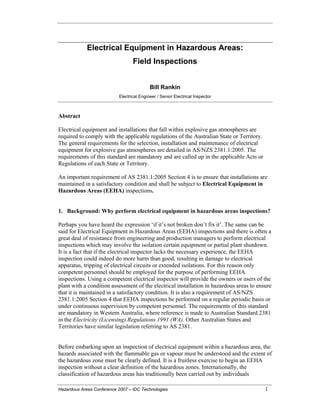Our Roar Solutions Statements
Our Roar Solutions Statements
Blog Article
Roar Solutions Things To Know Before You Get This
Table of ContentsThe smart Trick of Roar Solutions That Nobody is DiscussingThings about Roar SolutionsIndicators on Roar Solutions You Should Know
In order to protect installments from a possible explosion an approach of evaluating and categorizing a potentially unsafe area is required. The function of this is to make certain the appropriate choice and installation of tools to ultimately protect against an explosion and to ensure safety of life.(https://www.dreamstime.com/thomascarrillo4740_info)
No equipment needs to be mounted where the surface area temperature level of the equipment is more than the ignition temperature of the provided risk. Below are some typical dust harmful and their minimal ignition temperature level. Coal Dirt 380C 225C Polythene 420C (thaws) Methyl Cellulose 420C 320C Starch 460C 435C Flour 490C 340C Sugar 490C 460C Grain Dirt 510C 300C Phenolic Resin 530C > 450C Aluminium 590C > 450C PVC 700C > 450C Residue 810C 570C The chance of the threat being existing in a focus high adequate to create an ignition will vary from area to area.
In order to classify this threat a setup is divided into locations of danger relying on the quantity of time the dangerous exists. These areas are described as Areas. For gases and vapours and dusts and fibers there are 3 zones. Zone 0 Area 20 A hazardous ambience is highly most likely to be existing and might be existing for extended periods of time (> 1000 hours annually) or even continuously Area 1 Area 21 An unsafe ambience is possible but unlikely to be present for extended periods of time (> 10 450 C [842 F] A classification of T6 suggests the minimal ignition temperature is > 85 C [185 F] Harmful area electric devices maybe made for use in higher ambient temperature levels. This would certainly showed on the ranking plate e.g. EExe II C T3 Ta + 60C( This implies at 60C ambient T3 will certainly not be gone beyond) T1 T1, T2, T3, T4, T5, T6 T2 T2, T3, T4, T5, T6 T3 T3, T4, T5, T6 T4 T4, T5, T6 T5 T5, T6 T6 T6 A T Class rating of T1 indicates the maximum surface temperature level generated by the tool at 40 C is 450 C. Presuming the associated T Class and Temperature level score for the equipment are proper for the location, you can always use an instrument with a more rigid Department ranking than required for the location. There isn't a clear response to this inquiry. It really does rely on the kind of devices and what repair work require to be accomplished. Tools with certain examination procedures that can not be done in the field in order to achieve/maintain 3rd party ranking. Must return to the manufacturing facility if it is prior to the equipment's service. Area Repair By Authorised Personnel: Difficult testing may not be needed however particular treatments might need to be followed in order for the devices to maintain its 3rd party ranking. Authorised employees must be employed to perform the work properly Repair service must be a like for like replacement. New component should be taken into consideration as a straight substitute requiring no special testing of the equipment after the repair work is total. Each item of devices with a hazardous rating ought to be assessed individually. These are laid out at a high degree listed below, but for even more thorough details, please refer straight to the guidelines.
Get This Report on Roar Solutions
The tools register is a detailed data source of devices documents that includes a minimum collection of fields to identify each item's location, technological parameters, Ex classification, age, and ecological information. The proportion of In-depth to Close inspections will be established by the Equipment Risk, which is assessed based on ignition threat (the possibility of a resource of ignition versus the possibility of a combustible environment )and the hazardous area classification
( Zone 0Area 1, or 2). Applying a robust Risk-Based Assessment( RBI )technique is vital for guaranteeing conformity and security in managing Electrical Tools in Hazardous Locations( EEHA).
About Roar Solutions

In terms of explosive danger, a dangerous location is a setting in which an eruptive environment is existing (or may be anticipated to be present) in amounts that call for unique precautions for the building and construction, installment and usage of devices. eeha training. In this post we explore the challenges faced in the workplace, the risk control actions, and the required proficiencies to work securely
It issues of contemporary life that we make, store or take care of an array of gases or fluids that are considered flammable, and a range of dusts that are regarded combustible. These substances can, in certain conditions, develop eruptive ambiences and these can have major and terrible repercussions. The majority of us know with the fire triangle remove any type of one of the three elements and the fire can not happen, yet what does this mean in the context of hazardous locations? When damaging this down into its easiest terms it is basically: a combination of a certain amount of launch or leak of a particular material or material, mixing with ambient oxygen, and the visibility of a source of ignition.
In a lot of circumstances, we can do little concerning the degrees of oxygen in the air, but we can have considerable influence on sources of ignition, as an example electric equipment. Harmful areas are recorded on the hazardous location classification drawing and are recognized on-site by the triangular "EX" sign. Right here, among various other key details, areas are split right into three kinds relying on the risk, the likelihood and duration that an eruptive environment will exist; Area 0 or 20 is deemed the most harmful and Zone 2 or 22 is regarded the least.
Report this page